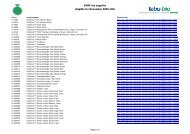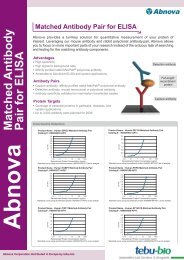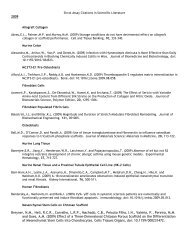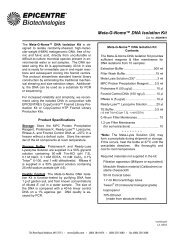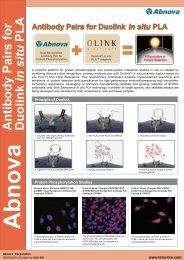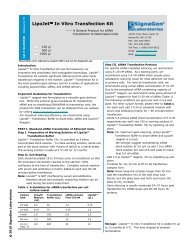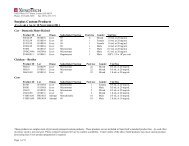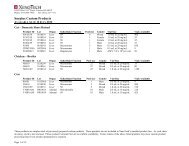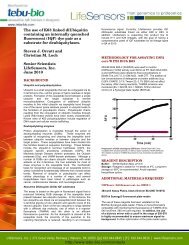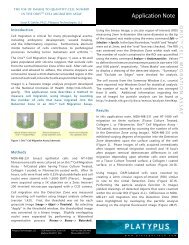Create successful ePaper yourself
Turn your PDF publications into a flip-book with our unique Google optimized e-Paper software.
<strong>FLAER</strong><br />
• Alexa fluor® 488 labelled reagent<br />
• More sensitive than CD59;<br />
detects small, abnormal granulocyte<br />
populations to a level of 0.5%<br />
• Now available in stabilized<br />
liquid and lyophilized formats<br />
Pinewood Scientific<br />
P a r o x y s m a l<br />
Nocturnal<br />
Hemoglobinuria
PNH: A progressive, destructive, and<br />
life-threatening disease<br />
Paroxysmal nocturnal hemoglobinuria (PNH) is a stem cell<br />
disorder caused by a mutation of a gene involved in the synthesis<br />
of the GPI (glycosylphosphatidylinositol) anchor of a<br />
group of surface proteins on circulating cells. Affected cells<br />
are sensitive to complement-mediated hemolysis and this<br />
may lead to life-threatening thrombosis, chronic kidney disease,<br />
pulmonary hypertension, end organ damage, ischemic<br />
bowel disease, hepatic failure, and anemia—all of which<br />
contribute to a shortened lifespan for patients with PNH.<br />
Identifying PNH patients early in the course of their disease<br />
may offer the best opportunity for long-term management.<br />
In the past, PNH has been challenging to identify effectively.<br />
However, in recent years impressive strides have been<br />
made in understanding of PNH pathology, accompanied by<br />
greatly improved detection techniques, including multiparametric<br />
flow cytometry using <strong>FLAER</strong>.<br />
Liquid <strong>FLAER</strong> and reconstituted improved<br />
powdered <strong>FLAER</strong> are equivalent.<br />
Both retain strong signals after at least<br />
4 months when stored at 4°C.<br />
www.cedarlanelabs.com<br />
ISO 9001 and ISO 13485 registered.<br />
About <strong>FLAER</strong><br />
<strong>FLAER</strong> is an Alexa® 488 labeled variant of aerolysin, a<br />
unique protein that binds tightly and specifically to mammalian<br />
GPI anchors. <strong>FLAER</strong> will not bind to PNH cells<br />
because they do not produce the anchor. Before <strong>FLAER</strong>,<br />
detection of PNH clones by flow cytometry relied on fluorescently<br />
labeled antibodies to GPI-linked proteins such as<br />
CD59 and CD55. These antibodies do not bind with high<br />
affinity, so that small PNH clones are not detected. Also,<br />
they each screen for the absence of a specific protein,<br />
rather than loss of the GPI anchor, and therefore there is<br />
the risk of false negative results. Since <strong>FLAER</strong> binds to the<br />
GPI anchor itself, only PNH cells, which lack the anchor,<br />
will be negative. And since <strong>FLAER</strong> binds with high affinity,<br />
very small PNH populations can be detected.<br />
<strong>FLAER</strong> (Alexa 488 proaerolysin variant)<br />
Format Size Est. # of Tests Cat #<br />
Powder 25 ug 50 FL1<br />
Powder 50 ug 100 FL2<br />
Liquid 25 ug 50 FL1S<br />
Liquid 50 ug 100 FL2S<br />
The products are for Research Use Only<br />
References<br />
A recent brief review of the status and importance of PNH and the key role of <strong>FLAER</strong> in detection by flow cytometry:<br />
Titus, K. (2009) Bringing wider meaning to a rare disease. Cap Today. January<br />
A recent published method for PNH detection using <strong>FLAER</strong>:<br />
Sutherland et al. (2007) Diagnosing PNH with <strong>FLAER</strong> and multiparameter flow cytometry. Cytometry Part B (Clinical Cytometry) 72B: 167-177<br />
A detailed protocol is available upon request.<br />
Alexa Fluor® is a registered trademark of Molecular Probes, Inc.<br />
Distributed By:



